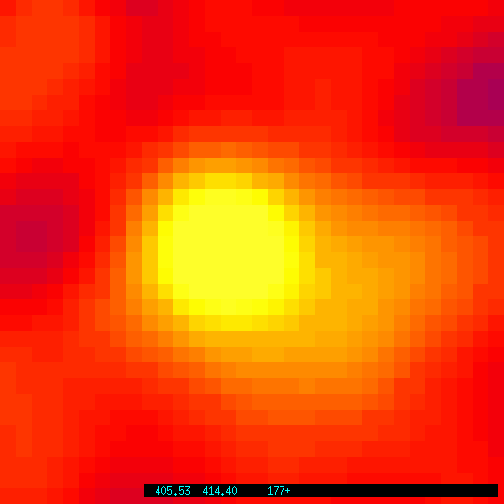Gamma-Ray Bursts Solved?
Astronomers may have solved one of the longest standing puzzles in science. Two optical counterparts to recent gamma-ray bursts (GRBs) are being scrutinized by the most powerful telescopes on earth and in space. The results of these observations seem to show the bursts originate billions of light years from earth.The discoveries are a result of new intruments and a new cooperation between gamma-ray, x-ray and optical astronomy. The Gamma-Ray Observatory (GRO) detects on average one burst per day. Unfortunately GRO cannot pinpoint the position of the object or objects causing the burst to a small region of the sky. This makes searches at other wavelengths are difficult.The launch of the BeppoSAX satellite changed that. Now more precise positions of GRBs can be determined at x-ray wavelenghts and relayed to astronomers using powerful optical telescopes on the ground and the Hubble Space Telescope (HST). Data from these telescopes show the GRBs to originate far outside our Milky Way galaxy.

Click image for larger view
BeppoSAX observations of GRB970228. On the left is the original observation of the burst February 28th. On the right is the same region of the sky, in the constellation of Orion, March 3rd showing the burst object has dimmed.
The first break in the case of the mysterious bursts came on February 28, 1997. Within hours of the detection of a burst designated GRB970228 by the BeppoSAX satellite, astronomers began searching the sky near the source of the x-rays with optical telescopes. They were rewarded with the first optical images of a GRB object.

Click image for larger view
Hubble Space Telescope image of the February 28th burst location.The fuzzy patch of light to the lower left of the bright burst has been identified as a distant galaxy.
Analysis of the HST images of the February 28 burst reveals the burst object is associated with a faint, fuzzy patch of light dwarfed by the brighter emission of the GRB source. This faint extended emission is presumed by many scientists to be a 'host' galaxy from within which some cataclysmic event led to the GRB. The unmatched resolution of the Hubble telescope allowed astronomers to determine the source of the burst does not lie at the center of the faint galaxy, but is offset, most likely in the disk population of normal stars. This would seem to rule out the possibility that the bursts are powered by massive black holes at the center of galaxies and suggests the products of typical stellar evolution like colliding neutron stars as GRB candidates. A galaxy like our own Milky Way could produce a bursting object every few million years, an explosion that for a few seconds outshines the entire galaxy.

Click image for larger view
By March 8th the GRB of February 28th has faded from sight.
Within a week of the February outburst the optical component had faded nearly out of sight, leaving only the faint smudge of its host galaxy. Of the more than 2,000 bursts detected by satellites in the past 6 years, only one burst location ever produced a second GRB. In all likelihood the source of the February 28 burst will not shine again.
Further insight to the source of GRBs came after another BeppoSAX observation, this time of a burst on May 8, 1997. Again within a few hours of the burst detection telescopes all over the workd were pointed towards the elusive source. Scientists at the Palomar Observatory identified an optical counterpart to the GRB that exhibited unusual variability in its brightness.

The variable optical component to the May 8th GRB.
The astronomers then turned to the worlds most powerful ground based telescopes, the10 meter Keck pair in Hawaii. By examing the wavelengths of specific spectra features present in the light form the variable source, the scientists were able to determine the distance to the source object. The GRB host was found to lie at a redshift of at least 0.8, or several billion light years from earth, over one half way across the observable universe. This is definative proof that at least some if not all the observed gamma-ray bursts are due to objects far beyond our own galaxy. Mark Metzger, a Caltech astronomy professor , said he was thrilled by the result. "When I finished analyzing the spectrum and saw features, I knew we had finally caught it. It was a stunning moment of revelation. Such events happen only a few times in the life of a scientist." For a few seconds the burst was over a million times brighter than an entire galaxy.
Recently, GRO recorded a bright GRB event, GRB 970616. The position of the burst accurate to about 2 degrees was derived and promptly disseminated. The region of sky was scanned by the Rossi X-Ray Timing Explorer (RXTE) within four hours of the GRO discovery. RXTE discovered an x-ray source several times brighter than those detected previously by SAX. Meanwhile, a greatly improved position was derived by combining the GRO measurement with a seperate detection of GRB 970616 by the Ulysees spacecraft. The RXTE x-ray source lies within this region of the sky. Follow up observations with RXTE one day later revealed that the source had faded below the detection limit. Thus, the source detected by RXTE was ,in all likelihood, the x-ray counterpart to GRB 970616, and follow up studies at optical wavelenghts can be performed.
These three NASA satellites, working in tandem, offer the possibility of greatly expanding the number of gamma-ray burts counterpart detections. No other events produce so much energy in so short a time. Gamma-ray bursts will continue to be studied in an attempt to discover just what can cause such violent and spectacular displays.
If you have a question about CGRO, please contact us via the Feedback form.

